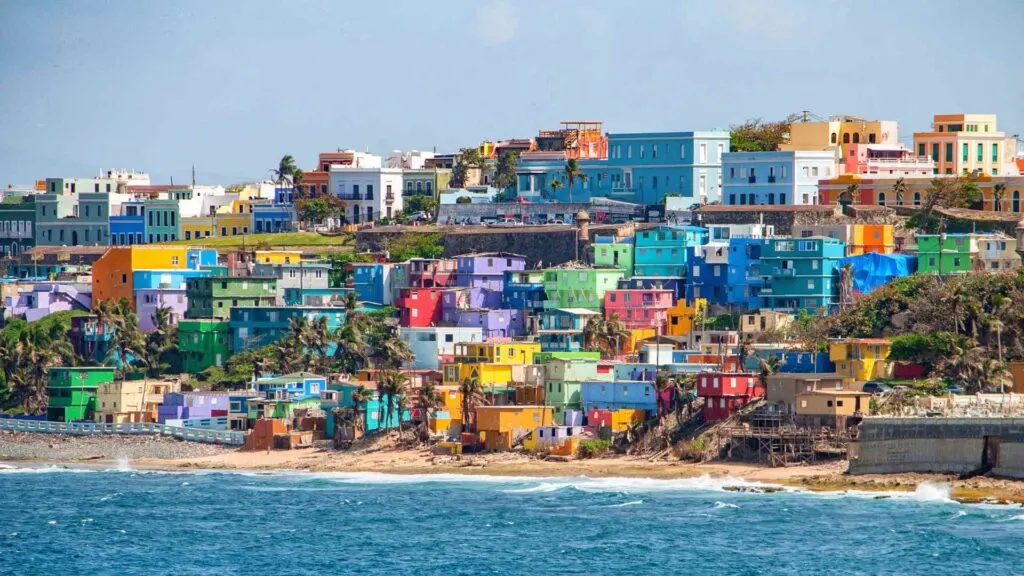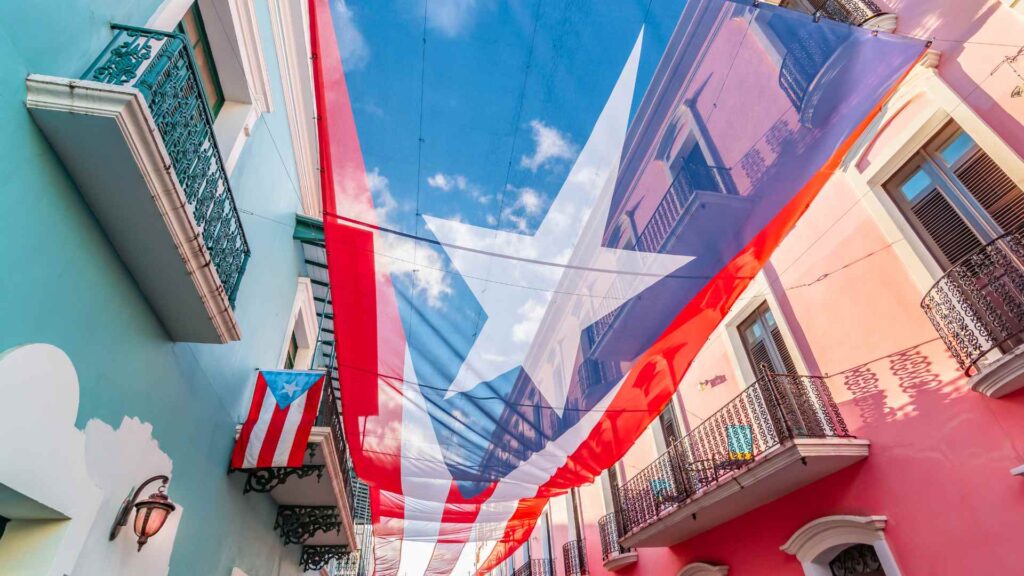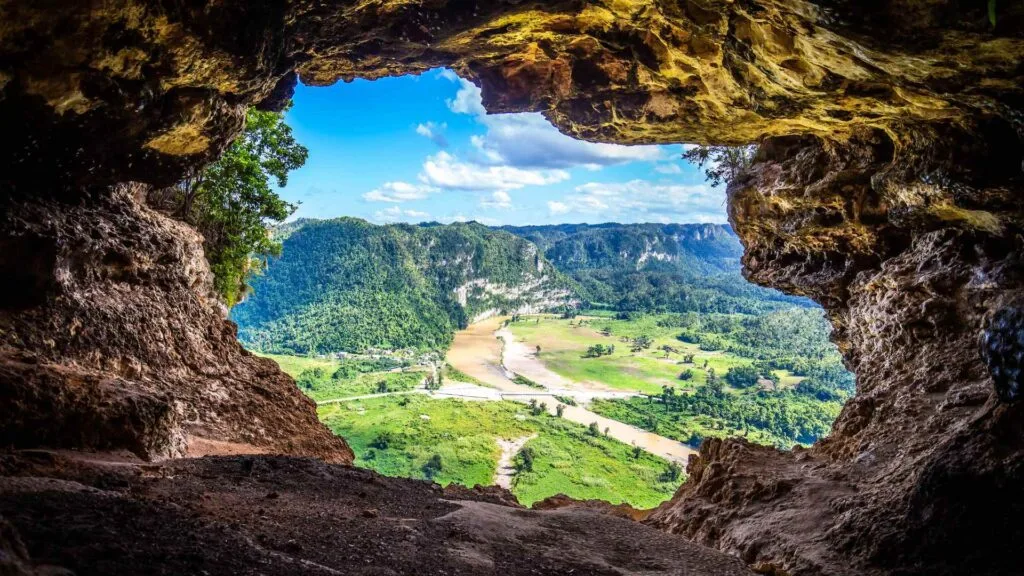Puerto Rico is a vibrant island packed with rich history, breathtaking landscapes, and a lively culture all its own.
This list covers 145 intriguing fun facts about Puerto Rico, grouped by themes that will spark your curiosity and deepen your appreciation for this Caribbean gem.
Rich History and Heritage
- Puerto Rico was named “San Juan Bautista” by Christopher Columbus in 1493, though the island itself became known as Puerto Rico.
- The indigenous Taíno people called the island “Borikén” or “Borinquen,” which translates to “Land of the Brave and Noble Lord.”
- Puerto Rico is a U.S. territory but maintains its own constitution, passed in 1952, giving it significant autonomy.
- The capital, San Juan, is the oldest European-established city in the United States, founded in 1521.
- Puerto Rico was under Spanish rule for over 400 years until the U.S. gained control in 1898.
- The flag of Puerto Rico was designed in 1895, inspired by the Cuban flag, symbolizing solidarity with Cuba’s independence struggle.
- The first Puerto Rican governor, Jesús T. Piñero, was appointed in 1946, a significant step toward self-governance.
- Old San Juan is home to two of the oldest forts in the Americas, Castillo San Felipe del Morro and Castillo San Cristóbal.
- Ponce de León, the first governor of Puerto Rico, searched for the Fountain of Youth in Florida.
- The island was a key location for sugar, coffee, and tobacco trade during Spanish rule.
- La Fortaleza in San Juan is the oldest executive mansion in continuous use in the Americas.
- Puerto Rico has its own Olympic team, despite being a U.S. territory.
- The Puerto Rican people voted for statehood in several referendums, but the U.S. Congress has not yet acted on it.
- In 1917, Puerto Ricans gained U.S. citizenship, allowing them to serve in the military.
- Juan Ponce de León’s house, Casa Blanca, is now a museum in Old San Juan.

Unique Cultural Traditions
- Puerto Ricans celebrate Three Kings’ Day on January 6, marking the end of the Christmas season with parades and festivities.
- Puerto Rico has one of the longest Christmas seasons, starting after Thanksgiving and ending in mid-January.
- Coquito, a traditional coconut-based drink, is popular during the holidays, often compared to eggnog.
- Puerto Rican households often hold “parrandas,” a type of Christmas caroling, during the holiday season.
- Quinceañeras are celebrated for girls turning 15, marking their transition to womanhood.
- Puerto Rican cuisine has African, Taíno, and Spanish influences, showcasing the island’s diverse cultural heritage.
- Bomba y plena are traditional Puerto Rican music and dance forms, originating from African and indigenous roots.
- Pilón, a wooden mortar and pestle, is commonly used in cooking and serves as a symbol of Puerto Rican culture.
- Espiritismo, a spiritual tradition blending Catholicism and indigenous beliefs, remains influential in Puerto Rican culture.
- Puerto Rican masks, or “vejigante masks,” are made for festivals and often symbolize the struggle between good and evil.
- Santería, an Afro-Caribbean religion, has influenced some Puerto Rican customs and beliefs.
- The island’s art scene is rich with murals, galleries, and sculptures that reflect its culture and history.
- Puerto Ricans observe Día de los Reyes (Three Kings’ Day) with feasts and gift exchanges.
- Puerto Rican proverbs and sayings, known as “refranes,” are used widely in daily conversations.
- La Plena is known as the “sung newspaper” of Puerto Rico, a folk music tradition that narrates social and political issues.

Stunning Natural Wonders
- El Yunque National Forest is the only tropical rainforest in the U.S. National Forest System.
- Puerto Rico is home to three bioluminescent bays, including Mosquito Bay, the brightest in the world.
- The island has more than 270 miles of coastline, with beaches known for their crystal-clear waters.
- Camuy River Cave Park features one of the longest underground rivers in the world.
- Puerto Rico’s 143 small islands include Culebra and Vieques, popular for snorkeling and diving.
- The beaches of Flamenco and Zoni on Culebra Island are among the world’s most beautiful.
- La Parguera is known for its glowing waters due to bioluminescent plankton.
- Mona Island, often called the “Galapagos of the Caribbean,” is a nature reserve home to rare species.
- Puerto Rico has five distinct ecosystems: mangroves, coral reefs, karst forests, lagoons, and tropical rainforests.
- Cabo Rojo’s salt flats and pink lagoons are natural wonders that attract visitors year-round.
- Toro Verde Adventure Park has one of the world’s longest zip lines, known as “The Monster.”
- Isla de Mona is a protected natural reserve that’s home to hundreds of species of plants and animals.
- The Guánica Dry Forest is one of the most extensive and best-preserved dry forests in the Caribbean.
- Cabo Rojo Lighthouse offers scenic ocean views and is one of Puerto Rico’s most photographed spots.
- The island’s mountainous terrain includes Pico de Punta, the highest peak in Puerto Rico.
Fascinating Wildlife
- The Puerto Rican parrot, once nearly extinct, is one of the world’s rarest parrots and a conservation success story.
- Puerto Rico’s bioluminescent bays light up due to the presence of microscopic organisms called dinoflagellates.
- The island’s coquí frog is famous for its loud “coquí” call, heard throughout Puerto Rico at night.
- Sea turtles, including leatherback and hawksbill species, nest on Puerto Rican beaches.
- Manatees inhabit Puerto Rico’s coastal areas and are often spotted in the mangroves.
- The Puerto Rican boa, an endangered snake, is one of the largest native reptiles on the island.
- The San Pedrito bird, or Puerto Rican tody, is known for its bright green and red colors.
- Iguanas, often called “Jurassic Park lizards” by locals, are commonly seen on the island.
- Wild horses roam freely on Vieques, a unique sight for visitors.
- The Caribbean monk seal, once found around Puerto Rico, is now extinct.
- Humpback whales migrate to Puerto Rican waters each winter, offering opportunities for whale-watching.
- The Mona ground iguana, found only on Mona Island, is one of the Caribbean’s largest lizards.
- Puerto Rico is a stopover for many migratory birds, making it a bird-watcher’s paradise.
- The Isla de Mona caves are home to rare bats, including the Puerto Rican flower bat.
- Culebra’s coral reefs support a vast variety of marine life, from colorful fish to vibrant coral species.

Delicious Puerto Rican Cuisine
- Mofongo, made from mashed plantains, is one of Puerto Rico’s most popular dishes.
- Puerto Rican coffee is known worldwide for its quality, with a tradition dating back to the 18th century.
- Pastelón, a sweet and savory lasagna-like dish made with plantains, is a Puerto Rican favorite.
- Arroz con gandules, or rice with pigeon peas, is a staple dish during holidays.
- Sofrito, a blend of herbs and spices, is the base for most Puerto Rican dishes.
- Puerto Rico is one of the world’s largest rum producers, with Bacardi as one of the major brands.
- Tostones, fried green plantains, are a popular side dish enjoyed by locals and tourists alike.
- Tembleque, a coconut-based dessert, is especially popular around the holidays.
- Puerto Rican-style “alcapurrias,” fried plantain and taro root fritters, are often filled with meat or seafood.
- Lechón, or roast pork, is a traditional dish for special occasions and holidays.
- Pan de mallorca, a sweet bread roll, is often enjoyed for breakfast with coffee.
- Bacalaítos, fried codfish fritters, are popular at beach kiosks and local festivals.
- Pitorro, a strong Puerto Rican moonshine, is commonly made during the Christmas season.
- Pollo guisado, a Puerto Rican chicken stew, is a comfort food staple.
- Piraguas, flavored shaved ice treats, are sold from colorful carts across the island.
Musical Heritage
- Salsa music, though popular worldwide, has deep roots in Puerto Rican culture.
- Reggaetón, a genre that originated in Puerto Rico, became a global sensation in the 2000s.
- The cuatro, a 10-string guitar, is Puerto Rico’s national instrument and is central to jíbaro music.
- Puerto Rico’s “La Bomba” is a unique blend of African rhythms and traditional dance.
- Plena music, known as “the sung newspaper,” tells the stories of Puerto Rican communities.
- Marc Anthony, Daddy Yankee, and Ricky Martin are some of Puerto Rico’s biggest music stars.
- Jíbaro music represents the folk music of Puerto Rico’s countryside, often played with guitar and güiro.
- The Festival of Bomba y Plena celebrates traditional Puerto Rican music with performances and dance.
- Danza, a classical Puerto Rican genre, features elegant rhythms that date back to the 19th century.
- Tego Calderón is recognized as one of the pioneers of Puerto Rican hip-hop and reggaetón.
- San Juan hosts annual music festivals that attract international artists and audiences.
- The Puerto Rican folk instrument, güiro, is often used in salsa and traditional music.
- La Plena’s “panderos,” handheld drums, are central to Puerto Rican folk music.
- Bad Bunny, a Puerto Rican artist, gained international fame as one of reggaetón’s leading figures.
- Bomba music’s call-and-response style reflects African roots brought by enslaved people.
Puerto Rican Festivals
- The San Sebastián Street Festival, held in January, is one of the biggest parties in Puerto Rico.
- The Ponce Carnival is a colorful pre-Lenten celebration featuring masks and traditional costumes.
- Festival de la Novilla in San Sebastián celebrates Puerto Rico’s agricultural roots with parades and live music.
- La Fiesta de Santiago Apóstol, held in Loíza, celebrates Afro-Puerto Rican heritage.
- The Saborea Puerto Rico food festival showcases local chefs and traditional dishes.
- Noche de San Juan, on June 23, is celebrated with a midnight swim to ward off bad luck.
- The Puerto Rican Day Parade, held in New York, celebrates Puerto Rican pride and culture.
- Fiestas Patronales, held in many towns, honor the town’s patron saint with music and festivities.
- The Festival del Apio in Barranquitas celebrates the town’s agricultural heritage.
- La Noche de San Sebastián brings live music, art, and parades to the streets of Old San Juan.
- Festival de Máscaras in Hatillo features elaborate masks and costumes representing Puerto Rican folklore.
- The Dia de los Muertos, or Day of the Dead, is observed in some parts with unique Puerto Rican twists.
- Fiestas de la Calle San Sebastián marks the end of Puerto Rico’s Christmas season.
- The Heineken JazzFest in San Juan attracts jazz musicians and fans from around the world.
- Puerto Rico’s Festival de la Palabra celebrates literature and brings international authors to the island.
Amazing Landmarks
- Castillo San Felipe del Morro, known as El Morro, is a 16th-century fortress overlooking San Juan Bay.
- El Capitolio in San Juan houses Puerto Rico’s Legislative Assembly and is open for public tours.
- The Arecibo Observatory, once the world’s largest radio telescope, was a groundbreaking site for astronomy.
- La Fortaleza is the oldest governor’s mansion in continuous use in the Western Hemisphere.
- Caguana Indigenous Ceremonial Park is one of the most important Taíno archeological sites in the Caribbean.
- The Ponce Firehouse, built in 1882, is one of Puerto Rico’s most iconic historic buildings.
- The Tibes Indigenous Ceremonial Center in Ponce preserves Taíno history and archeological finds.
- The San Juan Gate, a historic entrance to Old San Juan, welcomed travelers for centuries.
- The Museo de Arte de Ponce holds one of the most significant art collections in the Caribbean.
- El Faro Los Morrillos lighthouse in Cabo Rojo offers stunning views of the coast.
- The Paseo de la Princesa, a scenic walkway in Old San Juan, features sculptures and historic landmarks.
- The Museo del Niño in Carolina is a beloved children’s museum with interactive exhibits.
- El Tren Urbano, Puerto Rico’s only rapid transit system, serves the San Juan metropolitan area.
- The Luis Muñoz Marín Foundation, in the governor’s former home, highlights Puerto Rican political history.
- Isla de Cabras, a small island near San Juan, served as a leper colony in the 19th century.
Bonus Facts
- Puerto Rico doesn’t observe Daylight Saving Time.
- Vieques’ Mosquito Bay has the brightest bioluminescent waters in the world.
- The longest river in Puerto Rico, Río de la Plata, flows 60 miles across the island.
- Baseball is one of the most popular sports on the island.
- Puerto Rican boxing legends include Felix Trinidad and Miguel Cotto.
- Basketball is a major sport; Puerto Rico has a top-tier national team.
- Cockfighting is legal and was a traditional pastime, though now limited by U.S. laws.
- Puerto Rican Spanish includes many indigenous Taíno words.
- The National Anthem of Puerto Rico is “La Borinqueña.”
- The island’s official languages are Spanish and English.
- Puerto Rico’s ZIP code begins with 006 or 007.
- San Juan is a major cruise port, hosting millions of visitors each year.
- Puerto Rico has no voting representation in the U.S. Congress.
- Puerto Rican athletes have excelled in boxing, track, and field events.
- Salsa, a genre popular worldwide, has deep roots in Puerto Rican culture.
- Puerto Rico boasts one of the largest pineapple farms in the Caribbean.
- The island is known for its production of premium rum.
- Roosters are a common sight on the streets of San Juan.
- The coquí frog is considered a national symbol.
- The island’s unique piña colada is said to have been invented in San Juan.
